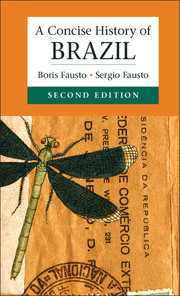Book contents
- Frontmatter
- Dedication
- Contents
- List of Maps
- Preface
- Map
- 1 Colonial Brazil (1500–1822)
- 2 Imperial Brazil (1822–1889)
- 3 The First Republic (1889–1930)
- 4 The Vargas State (1930–1945)
- 5 The Democratic Experiment (1945–1964)
- 6 The Military Government and the Transition to Democracy (1964–1984)
- 7 Modernization under Democracy (1985–2010)*
- Bibliography
- Index
4 - The Vargas State (1930–1945)
Published online by Cambridge University Press: 05 August 2014
- Frontmatter
- Dedication
- Contents
- List of Maps
- Preface
- Map
- 1 Colonial Brazil (1500–1822)
- 2 Imperial Brazil (1822–1889)
- 3 The First Republic (1889–1930)
- 4 The Vargas State (1930–1945)
- 5 The Democratic Experiment (1945–1964)
- 6 The Military Government and the Transition to Democracy (1964–1984)
- 7 Modernization under Democracy (1985–2010)*
- Bibliography
- Index
Summary
Government Action
Having risen to power in October 1930, Getúlio Vargas remained there for 15 years: as head of the provisional government, as a president elected by indirect votes, and as dictator. He would be reelected president in 1950 by a popular vote, but he would not complete his mandate because he committed suicide in 1954.
The most weighty figure in Brazil’s 20th-century political history came from a family of ranchers in São Borja, located in the Campanha region of Rio Grande do Sul. His father was a local PRR leader and became involved in their struggles with the Federalists. Vargas worked under the wing of Borges de Medeiros, and his career was, up to 1930, typical of the PRR. He was a district attorney, a deputy in the state legislature, the leader of the Gaúcho contingent in the federal Chamber of Deputies, Washington Luis’s minister of finance, and governor of the state of Rio Grande do Sul. In 1930, Vargas leaped into the nation’s presidency and began a government very different from Brazil’s oligarchical administrations.
- Type
- Chapter
- Information
- A Concise History of Brazil , pp. 193 - 230Publisher: Cambridge University PressPrint publication year: 2014
- 1
- Cited by

